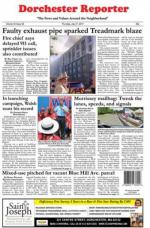December 23, 2010
While only 55 percent of all Dorchester and Mattapan residents participated in the 2010 United States Census, a fresh snapshot of the neighborhood’s current demographics is emerging this week through the American Community Survey (ACS), a four-year study that points to some emerging trends locally.
The ACS does not provide a precise figure on how many people live in a given community, but the sample can suggest changes in ethnic composition, income levels and certain behaviors.
According to an initial review of statistics from the ACS conducted by the Reporter, Dorchester has seen its Asian population decrease by nearly half, from 11 percent to 6 percent, while the black population has increased from 37 to 48 percent and the white population has decreased from 34 to just over 30 percent.
Mattapan’s demographics have remained relatively stable with the black population counting in at 78 percent, down 3 percent from 2000. Asian and biracial populations have seen no major movement in recent years however the white population has increased from 6 percent to 11 percent of the neighborhood.
Officials at the Boston Redevelopment Authority (BRA) are busy crunching numbers from the survey now in preparation for a February 2011 report. But a significant change in the way the federal government compiled information for this year’s national headcount could make tracking demographic shifts a “statistical nightmare,” according to one top official.
In an effort to increase the national participation rate for the 2010 population count, the US Census Bureau did away with the 110-question “long format” survey issued to a randomly selected households and meant to document features like household income, ancestry, and means of transportation. To gather more detailed information, the bureau instead relied on the American Community Survey, which reviews a smaller sample group and has produced numbers the BRA fears can muddy their understanding of how Boston has grown in the past decade.
BRA director of research Alzaro Lima said small ACS sample groups can skew his office’s neighborhood demographic reports, especially when they are compared to the much larger, more reliable numbers produced through the 2000 long-form survey.
“Some [Census] tracts have 300 people, but the margin of error is 400 to 500 people,” Lima said. “We are trying to navigate this incredible statistical mess.”
Despite the technical issues, Lima said the BRA research department anticipated the problems caused by the data discrepancy and is working closely with the local Census branch to produce accurate reports by the February 2011 deadline.
While the piecemeal nature of the ACS makes it impossible to give exact numbers, the Reporter has used the percentages provided by this report to track some of the changes Dorchester and Mattapan have seen over the past decade.
The ACS indicates more Mattapan students are hitting the books for longer, with 35 percent of all students completing high school or receiving a GED before entering the workforce, compared to the 20 percent in 2000. The number of students attending and completing a four-year college has also increased noticeably from nine to 12 percent.
While Mattapan residents are reporting higher levels of education, Dorchester has seen little change in academic achievement levels. One percent more Dorchester students are completing high school or receiving a GED before entering the workforce at 31 percent, while one percent more students are completing a bachelor’s degree than in 2000 with a slight increase from 13 to 14 percent.
Despite increases in MBTA ridership, Dorchester and Mattapan residents are spending nearly the same amount of time traveling to work as they did ten years ago. In Mattapan, 35 percent of all workers spend 30 minutes or less in transit— up one percent from 2000— and 48 percent spend between 30 minutes and an hour to reach their jobs; the remaining 17 percent face hour-long commutes.
Dorchester commuters are more likely to experience shorter trips to work, however these rates have also stayed in line with 2000 numbers. About 44 percent of Dorchester residents surveyed spend less than half an hour each way in their commute. Another 43 percent spend between a half-hour to an hour traveling and 13 percent spend more than an hour getting to their jobs.
While Dorchester residents may spend less time traveling to work, families are making 34 percent less money now than they did in 2000 after accounting for inflation, with the median family income dropping from $48,930 to $32,216. On the other hand, Mattapan families have become more prosperous, increasing their median income by 36 percent, making $59,292 compared to $43,477 in inflation-adjusted dollars.



